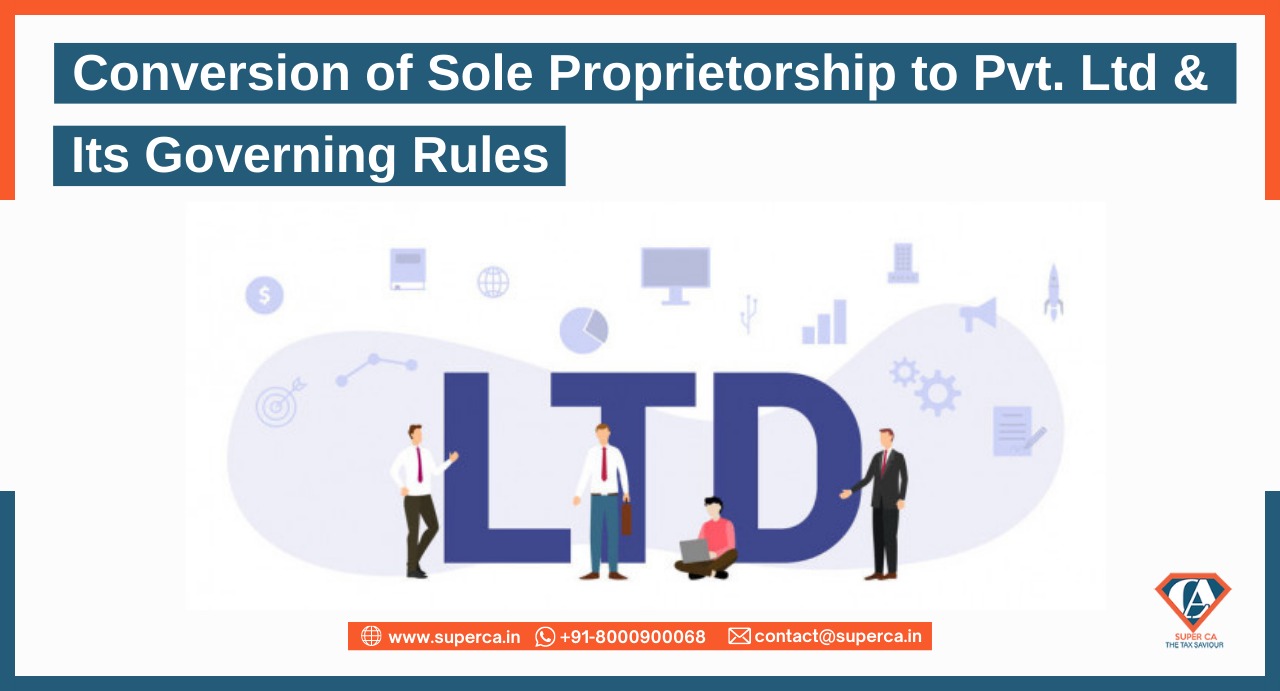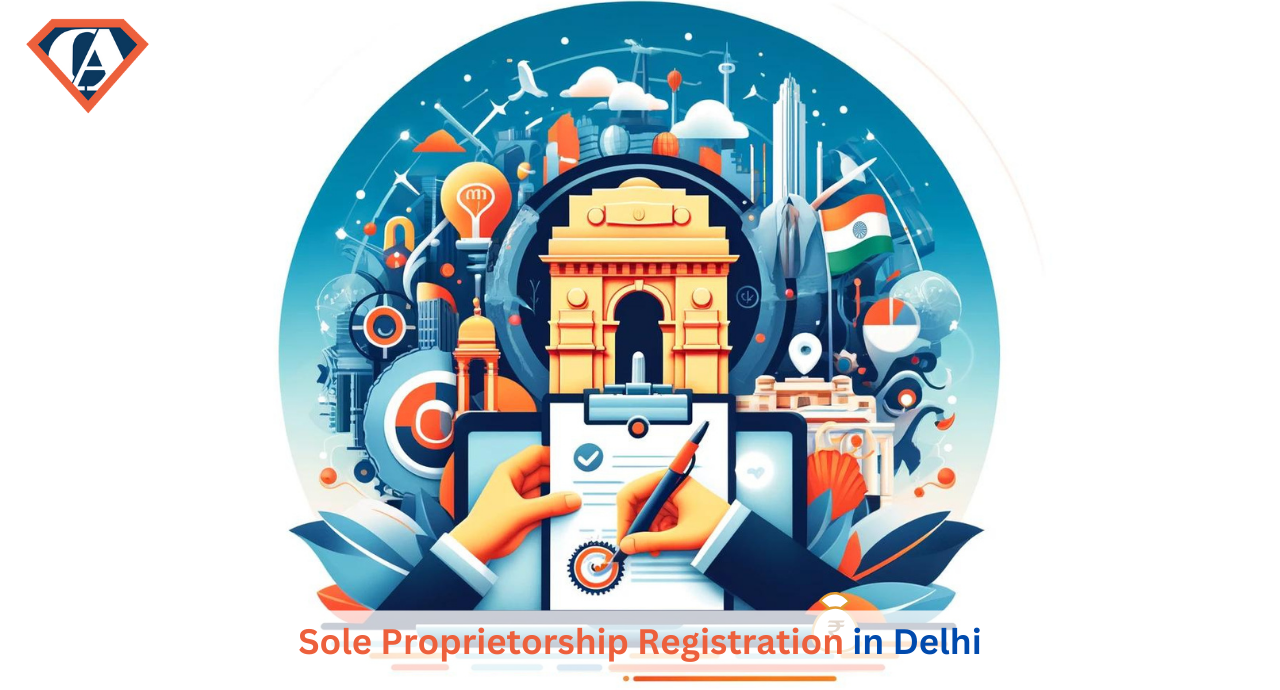Conversion of Sole Proprietorship to Pvt. Ltd and its Governing Rules
- Posted By SuperCA
- On 13 November

About
A private limited company and Sole Proprietorship are two different business structures & also are different in terms of their working.
Sole Proprietorship registration is a popular type of enrollment of unregistered business institution owned, managed, and operated by a single person. Sole proprietorship is the “One Man Business Entity”. All the investments for the business with sole proprietorship registration is done by the single proprietor who bears all the losses and enjoys all the profits. The overall control of the business as well as its management is in his hands. He can appoint individuals for conducting the business, but the ownership will rest solely with him.
This type of business is easy to start but can also hamper your growth with time. After all, it’s difficult to build a big business as a single person. Also, a sole proprietorship registration cannot get all benefits of operation as it grows. So, a need to convert the proprietorship into a private limited company will arise. This conversion can bring in its wake all the benefits of a company like higher capital, limited liability, and so on.
If one is looking to add directors and capital expansion to their business without any hassle or hindrance, then it is recommended to switch to a private limited company. Conversion of a business with sole proprietorship registration to a Pvt. Ltd. is possible and you can always choose to do so. It is very common for sole proprietors to convert their business into other legal firms like partnerships and private limited companies after the business starts growing. But due to a ton of information scattered online, many people get confused on the right process.
Prerequisites For Forming a Private Limited Company
The procedure to form a private limited company from a business with sole proprietorship registration is to first form the private limited company and then take over the sole proprietorship through a Memorandum Of Association (MoA) and transfer all benefits and liabilities to the limited company. The proprietor should ensure compliance with the following requirements before beginning the conversion of proprietorship into company:
⇢ The owner of the sole proprietorship needs to be one of the directors of the limited company.
⇢ A minimum of two directors are a must for the formation of a private limited company . One of them can be the proprietor himself, and the other can be any individual.
⇢ The directors need to have their Director Identification Number (DIN) as a prerequisite to incorporation.
⇢ The company needs to have a minimum of two shareholders, and they can be the same as the directors.
⇢ The company should have a minimum authorised capital of 1 Lakh rupees.
Important Conditions for Conversion
⇢ A takeover agreement or sale agreement needs to be entered into between the sole proprietor and the company. .
⇢ All the assets and liabilities of the sole proprietorship must be transferred to the new Pvt. Ltd. company.
⇢ The shareholding of the proprietor should not be less than 50% of the voting power, and the same must continue to be held for a period of 5 years from the date of the succession.
⇢ The sole proprietor does not receive any benefit or consideration, directly or indirectly, in any form or manner, other than by way of allotment of shares in the company.
Procedure
The following procedure needs to be followed for the conversion of proprietorship to a Pvt. Ltd.-
Step 1 - All the slump sale formalities must be completed by the proprietor.
Step 2 - All the concerned Directors must obtain their Director Identification Number (DIN) and the Digital signature certificate (DSC).
Step 3 - The next step is acquiring permission for naming the company, the application for which must be made in Form-1. The proprietor must apply for the availability of name in Form – 1.
Step 4 -Prepare the Memorandum Of Association (MoA) and Articles of Association (AOA) of the company describing the objects and the rules of the company.
Step 5 -Submit all the relevant documents required and then apply for the incorporation of the company to the Ministry of Corporate Affairs (MCA). The forms to be submitted to the MCA are:
⇢ Form 1 is to be filed with the MOA, AOA and other documents.
⇢ Form 18 which provides the details of the registered office.
⇢ Form 32 which contains particulars of the information of the directors.
Documents Required for conversion
- Copy of PAN Card of the Directors
- Passport size photograph of Directors
- Copy of Aadhaar Card/ Voter identity card
- Copy of Rent agreement(If rented property)/ Copy of Property papers (If owned property)
- Electricity/ Water bill (Business Place)
- NOC from the Landlord.
Step 6 - After the completion of all the procedures specified above, the MCA validates the prescribed compliance requirements. If it finds it satisfactory, you will be provided with a Certificate of Incorporation, which effectively gives birth to a new private limited company.
Step 7 - Apply for a new PAN and TAN.
Step 8 - Make modifications in the bank details as per the conversion.
Cessation
Conversion of a sole proprietorship registration into a private limited company provides many benefits, but it also brings along the diffusion of power and loss of independence. Therefore the decision must be taken after careful consideration of all the factors involved and see if it genuinely brings about privileges intended.
It was the overall process of converting a business with sole proprietorship registration into a private limited company. It should also be noted that almost the same procedures mentioned above apply in other cases, where one legal entity converts into any other legal firm.





